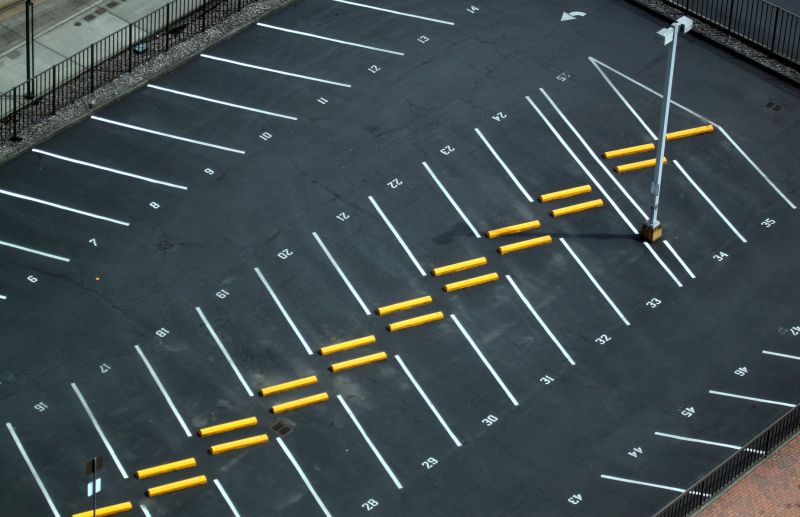Expert Picks Of Parking Lot Marking Equipment For Safety and Compliance
Find the top products trusted by professionals to ensure your parking lot meets safety standards and remains well-marked.
 Parking lot markings serve as essential visual guides that facilitate safe and efficient vehicle movement within commercial, public, and private parking areas. These markings help delineate parking spaces, traffic lanes, pedestrian pathways, and safety zones, contributing to overall site organization. Selecting the right products for parking lot markings involves understanding various materials, durability requirements, and application methods to ensure longevity and visibility. Properly marked parking lots enhance user experience and support compliance with safety standards.
Parking lot markings serve as essential visual guides that facilitate safe and efficient vehicle movement within commercial, public, and private parking areas. These markings help delineate parking spaces, traffic lanes, pedestrian pathways, and safety zones, contributing to overall site organization. Selecting the right products for parking lot markings involves understanding various materials, durability requirements, and application methods to ensure longevity and visibility. Properly marked parking lots enhance user experience and support compliance with safety standards.
Top Overall Option
Premium Thermoplastic Parking Lot Marking Material
This thermoplastic marking material is designed for durability and high visibility, offering excellent resistance to weather, chemicals, and traffic wear. Its reflective properties enhance nighttime visibility, making it a reliable choice for various parking lot environments. Properly applied, it can provide long-lasting markings with minimal maintenance, supporting safety and organization over time.
Types of Products For Parking Lot Markings
Spray Paints
Quick-drying and easy to apply, suitable for temporary or low-traffic markings.
Thermoplastic Markings
Heat-applied for long-lasting, reflective lines resistant to weather and wear.
Epoxy Line Coatings
High-strength coatings that provide durable, slip-resistant markings.
Liquid Cold Plastic
A fast-curing, cold-applied alternative to thermoplastics for durable lines.
Reflective Tape
Flexible, adhesive-backed tape for quick installation and enhanced visibility.
Chalk Markings
Temporary markings ideal for short-term or event-specific needs.
Paint Marking Stencils
Pre-cut stencils to create precise symbols, arrows, and text.
Line Striping Machines
Equipment for professional-grade application of various marking materials.
UV-Resistant Marking Paints
Paints formulated to withstand prolonged sun exposure without fading.
High-Visibility Marking Films
Durable films with reflective surfaces for clear, long-lasting lines.
Glow-in-the-Dark Markings
Specialized markings that enhance visibility in low light conditions.
Anti-Slip Coatings
Surface treatments that improve traction and safety on markings.
Traffic Paints
Standardized paints designed for marking traffic lanes and symbols.
Eco-Friendly Marking Products
Less toxic options for environmentally conscious applications.
Magnetic Marking Sheets
Reusable magnetic symbols and lines for flexible parking lot management.
Popular Choices
Widely used for their durability and high reflectivity, suitable for various traffic conditions.
Common for quick, straightforward applications and temporary markings.
Popular for their ease of installation and enhanced nighttime visibility.
Favored for their quick curing time and durability in high-traffic areas.
Chosen for their ability to withstand sun exposure without fading.
Preferred by professionals for creating clean, consistent lines.
Increasingly popular for safety and visibility in low-light conditions.
Used for their long-lasting, reflective properties and ease of application.
Common for temporary or event-specific parking lot markings.
Popular for improving safety on painted lines and symbols.
Standard choice for marking lanes, arrows, and symbols on asphalt surfaces.
Increasingly selected for their lower VOC emissions and safer handling.
Different types of marking products are designed to meet specific needs based on traffic volume, weather conditions, and surface types. For instance, some markings are formulated for high-traffic areas and require resistant, long-lasting materials, while others are suited for temporary or low-traffic zones. The choice of product can influence maintenance frequency, visibility under different lighting conditions, and resistance to wear and tear. It is important to consider these factors carefully to select markings that maintain clarity over time.
Application techniques vary from simple spray paints to advanced thermoplastic materials that require specialized equipment. Spray paints are often used for quick, cost-effective markings, but may need frequent reapplication. Thermoplastic markings, on the other hand, offer increased durability and are often heat-applied to create highly reflective lines that withstand harsh weather and traffic conditions. Proper surface preparation and application are critical to ensure the markings adhere correctly and last as long as possible. Consulting with professionals or following manufacturer instructions can help achieve optimal results.
Maintenance and reapplication are ongoing considerations for parking lot markings. Regular inspections can identify fading, cracking, or peeling that may impair visibility and safety. Choosing products with high reflectivity and resistance to UV rays and chemicals can minimize maintenance efforts. Additionally, considering the specific needs of your parking lot—such as size, layout, and expected traffic—will guide you toward the most suitable marking solutions. Ultimately, investing in quality products and proper application techniques contributes to a well-organized and safe parking environment.
Key Buying Considerations
- Durability and resistance to weather, chemicals, and traffic wear.
- Visibility under different lighting conditions, including night and low light.
- Application method and equipment requirements for proper installation.
- Surface compatibility, ensuring the product adheres well to asphalt or concrete.
- Curing time and ease of reapplication or touch-up.
- Reflective properties for enhanced nighttime visibility.
- Environmental conditions such as temperature and humidity during application.
- Cost-effectiveness over the lifespan of the markings.
- Regulatory compliance and safety standards for traffic markings.
- Maintenance requirements and ease of cleaning or re-marking.
- Type of traffic the markings will endure, including heavy or light vehicle traffic.
- Color options and their visibility contrast with the surface.
- Availability of complementary products like stencils or striping equipment.
- Environmental impact of the marking materials, if relevant.
